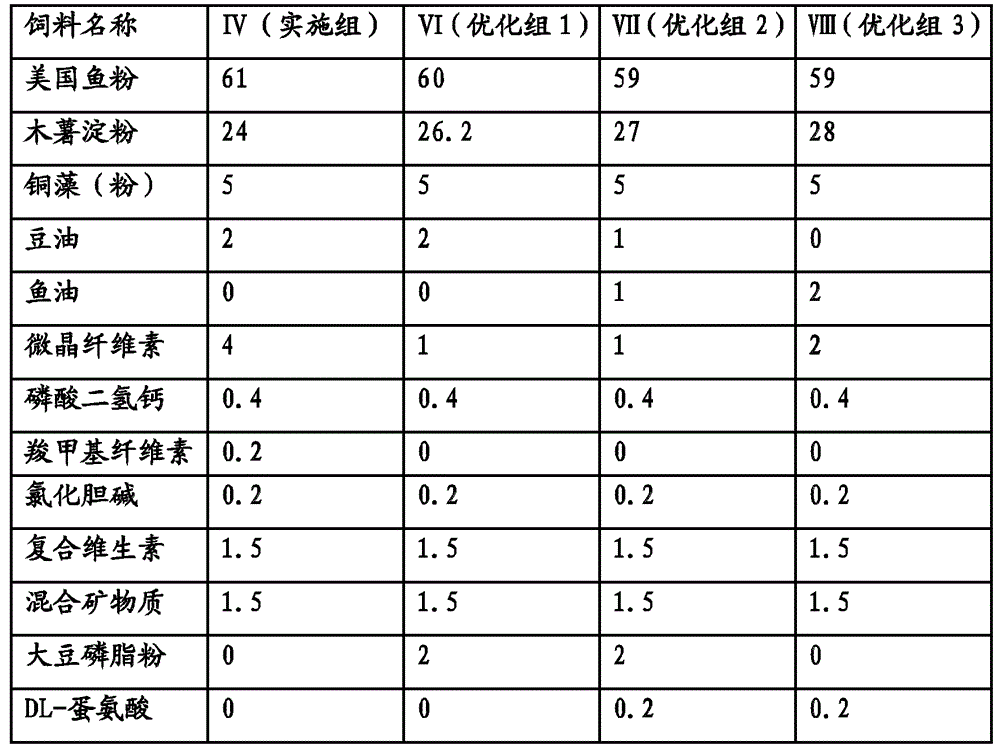Lutjanus stellatus feed containing Sargassum horneri and preparing method of Lutjanus stellatus feed
A technology for star snapper and feed, which is applied in the field of star snapper feed containing copper algae and its preparation, can solve the problems of low survival rate, unbalanced nutrition and high feed coefficient, achieves reduction of protein demand level, and promotes juvenile growth. The effect of high fish growth, digestion and absorption rate
- Summary
- Abstract
- Description
- Claims
- Application Information
AI Technical Summary
Problems solved by technology
Method used
Image
Examples
Embodiment 1
[0021] In order to detect the most suitable addition amount of copper algae, the dry powder of copper algae added 0 (control), 5%, 10%, 15%, and 20% was used to replace fish meal or other plant protein sources to make compound feed for spot snappers. Feed formula is as shown in table 1 (value is percentage by weight), and preparation steps are as follows:
[0022] ①Collect fresh copper algae, clean them, remove impurities, and dehydrate them with a centrifugal dehydrator. The rotational speed of the centrifugal dehydrator is 3000-5000 rpm, and the centrifugal dehydration takes 3 to 10 minutes.
[0023] ② Preparation of copper algae powder: Put the dehydrated copper algae in a drying oven to dry, the drying temperature is set at 70-85°C, the drying time is set at 4-5 hours, and the moisture content of the dried copper algae is controlled at 10-15 %, and then pulverized to 80-120 mesh with a pulverizer, and set aside.
[0024] ③ Mixing: according to the feed formula shown in Ta...
Embodiment 2
[0028] In order to obtain the best feed formula for spot snapper containing copper algae, on the basis of copper algae content of 5%, the ratio of raw materials and auxiliary materials was adjusted to make different compound feeds for spot snapper. The feed formula is shown in the table Shown in 2 (numerical value is percentage by weight), preparation procedure is the same as embodiment 1.
[0029] Table 1
[0030]
[0031]
[0032] Note: a. Tapioca starch is a commercially available product and can be purchased from the domestic raw material market;
[0033] b. The fish meal is American fish meal, with a crude protein content of 68% and a fish oil content of 9.4%;
[0034] c. The protein content of copper algae powder is 17.6%, the crude fat content is 1.25%, the crude fiber is 8.88%, and the ash is 16.13%; the amino acid content (g / 100g, dry weight) in the copper algae is: threonine (Thr)* 0.68, Valine (Vla)*0.94, Methionine (Met)*0.31, Isoleucine (Ile)*0.77, Leucine...
Embodiment 3
[0040] With the formulated feed prepared in Example 1, about 12 g of spot snappers were raised. Present embodiment is the net cage culture that fish raft is carried out in sea, and culture net cage is 1 * 1 * 1.5m, has cover net, in order to escape and waterfowl. Three parallel experiments were performed in each group, and 30 fish were tested in each parallel experiment. During the breeding period, the temperature was 20-26° C., and the salinity was 27-31 degrees. After 60 days of cultivation, various growth indicators were measured. The results of Example 1 are shown in Table 3.
[0041] table 3
[0042]
[0043] Note: The data are mean ± standard error; SGR: specific growth rate; in peer data, those marked with the same lowercase letters indicate significant differences between each other (P<0.05)
PUM
 Login to View More
Login to View More Abstract
Description
Claims
Application Information
 Login to View More
Login to View More - R&D
- Intellectual Property
- Life Sciences
- Materials
- Tech Scout
- Unparalleled Data Quality
- Higher Quality Content
- 60% Fewer Hallucinations
Browse by: Latest US Patents, China's latest patents, Technical Efficacy Thesaurus, Application Domain, Technology Topic, Popular Technical Reports.
© 2025 PatSnap. All rights reserved.Legal|Privacy policy|Modern Slavery Act Transparency Statement|Sitemap|About US| Contact US: help@patsnap.com



